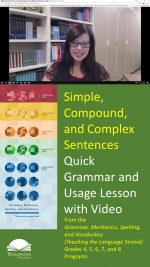Commas after Introductory Clauses
Commas after Introductory Clauses
Play the quick video lesson HERE and click the upper left back arrow to return to this lesson.
Common Core Language Standard 2
Although English-language arts teachers and professional writers do disagree among themselves about when to place commas after introductory words and phrases, none of them would disagree with placing commas following introductory clauses.
Today’s mechanics lesson is on commas with introductory clauses. Remember that a clause has a noun and a connected verb. An independent clause is part of a sentence that has a noun and verb expressing a complete thought. A dependent clause has a noun and verb, but does not express a complete thought.
Now let’s read the mechanics lesson and study the examples.
Use commas after introductory clauses. Example: If I had remembered her name, I would not have had to ask.
Now circle or highlight what is right and revise what is wrong according to mechanics lesson.
Practice: However much they pretend, they can’t convince me. If Frank and Anna were really serious they would prepare a better plan.
Let’s check the Practice Answers.
Mechanics Practice Answers: However much they pretend, they can’t convince me. If Frank and Anna were really serious, they would prepare a better plan.
Now let’s apply what we have learned.
Writing Application: Write your own sentence using an introductory clause.
*****

Pennington Publishing Grammar Programs
Teaching Grammar, Usage, and Mechanics (Grades 4, 5, 6, 7, 8, and High School) are full-year, traditional, grade-level grammar, usage, and mechanics programs with plenty of remedial practice to help students catch up while they keep up with grade-level standards. Twice-per-week, 30-minute, no prep lessons in print or interactive Google slides with a fun secret agent theme. Simple sentence diagrams, mentor texts, video lessons, sentence dictations. Plenty of practice in the writing context. Includes biweekly tests and a final exam.
Grammar, Usage, and Mechanics Interactive Notebook (Grades 4‒8) is a full-year, no prep interactive notebook without all the mess. Twice-per-week, 30-minute, no prep grammar, usage, and mechanics lessons, formatted in Cornell Notes with cartoon response, writing application, 3D graphic organizers (easy cut and paste foldables), and great resource links. No need to create a teacher INB for student make-up work—it’s done for you! Plus, get remedial worksheets, biweekly tests, and a final exam.
Syntax in Reading and Writing is a function-based, sentence-level syntax program, designed to build reading comprehension and increase writing sophistication. The 18 parts of speech, phrases, and clauses lessons are each leveled from basic (elementary) to advanced (middle and high school) and feature 5 lesson components (10–15 minutes each): 1. Learn It! 2. Identify It! 3. Explain It! (analysis of challenging sentences) 4. Revise It! (kernel sentences, sentence expansion, syntactic manipulation) 5. Create It! (Short writing application with the syntactic focus in different genre).
Get the Diagnostic Grammar, Usage, and Mechanics Assessments, Matrix, and Final Exam FREE Resource:
![]()






